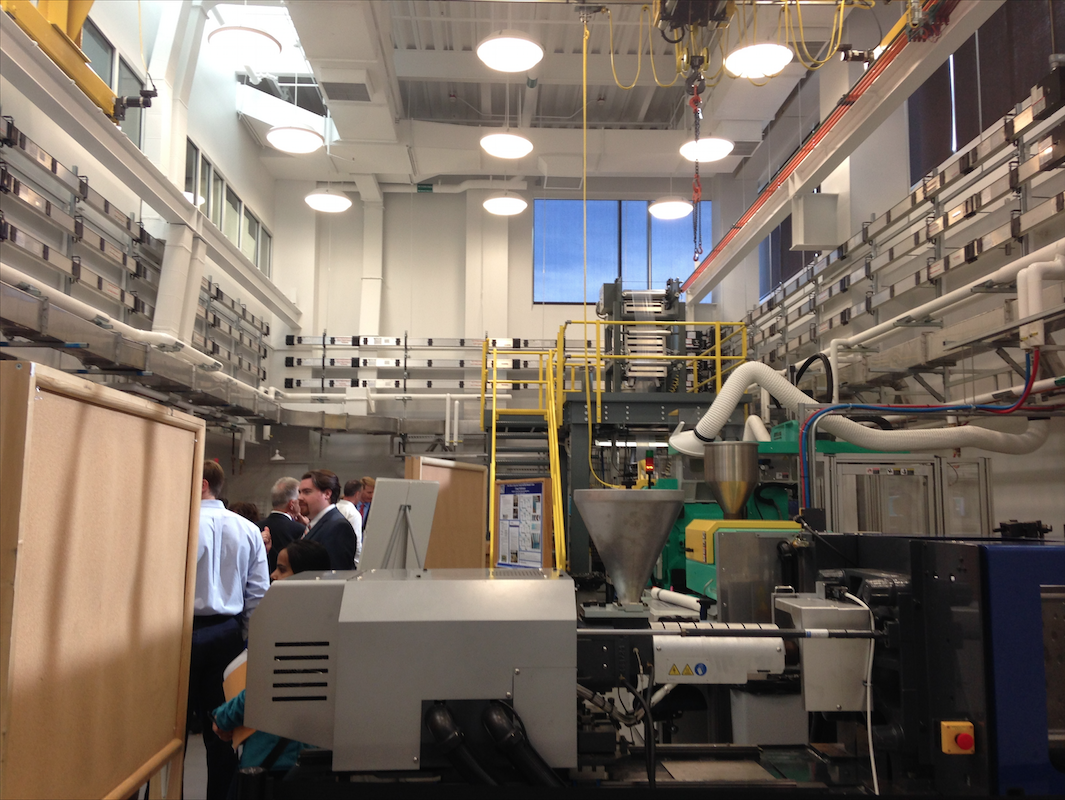Dave Rudderham
Connector Editor
The Raytheon-UMass Lowell Research Institute officially opened with a recent ribbon cutting ceremony at the newly constructed Mark and Elisia Saab Emerging Technologies and Innovation Center. The building is an $80 million, 84,000-square-foot research facility making it one of 10 new buildings opened by UMass Lowell since 2009.
During the ceremony, Raytheon workers toured the new building and observed some of UMass Lowell’s best and brightest students show off new technology, as well as ideas developed by students and faculty. One of these best and brightest was JeongIn Gug, a UML student who works in plastics engineering on the first floor of the new building.
“Here we do the research and the property test before it gets sent to practical applications,” said Gug, standing in front of a large mechanical injection-molding machine Injection molding is just one part of the process and that the amount of filler used can determine whether or not the plastic is flexible or hardened, he said.
Down the hall on the same floor was a display for the iglobe, a large diameter spherical screen. Imagine a large high definition television being bent around a curve until the screen made a perfect sphere. Now imagine that TV still works afterward. Interesting technology such as this were displayed throughout the building.
The Raytheon-UMass Lowell Research Institute (RURI) is located on the fourth floor, and it is here that students will be focusing on electrical and computer engineering while collaborating with the company. The nametags of all the attendees that night featured radio-frequency identification (RFID) tags, something that the new institute specializes in.
Ali Apelin, a representative from Raytheon, explained to onlookers how the business’ VHX-5000 digital microscope operates. She pressed some keys on the computer and the microscope began to scan the microchip and it automatically zoomed in and focused to where she wanted it, as if it were a robot.
UML students worked on the microchip that was scanned under the microscope, which represented what can be done with what is known as a flexible substrate. These chips are tiny and durable and they can bend without breaking. It is this technology that makes up the RFID tags that all the attendees were wearing.
“These microscopes are very powerful and can give the user a detailed view of anything,” said Apelin as she rotated a knob and showed how the sides of the chip can also be viewed. The chip looked as if it was rotating on an axis, allowing me to see it in three dimensions without the image ever going out of focus.
Down the hall was Peilong Li, a UML student explaining his diagram for a faster processing chip. Him and his colleagues found a way of attaching an accelerator to an Intel i7 chip that would allow the clock speed to be considerably faster.
Although it sounds similar to overclocking, this accelerator does it in a way that consumes far less energy and therefore doesn’t cause overheating despite being so effective at boosting clock-processing speeds. “It doesn’t have the energy consumption problem,” said Li while comparing an accelerated chip to a normal one.
Li represents exactly the sort of bright-minded student that will be working in RURI, in a marriage between high tech and learning, between Raytheon and UMass Lowell. Paul Ferraro, the V.P. of Raytheon, explained this marriage succinctly.
“It’s a place where academics and industry can meet over coffee and lunch,” says Ferraro. Other speakers before the ribbon cutting shared his enthusiasm and optimism for what the Vice-Provost for Research Julie Chen referred to as “A place where ingenuity meets industry.”
Chancellor Marty Meehan said, “We hope it becomes a model for industry,” in his speech in a room crowded with Raytheon workers and faculty. “We’re very proud to be the first institution for Raytheon to partner with.”
Other speakers included Congresswoman Niki Tsongas, Mayor of Lowell Rodney Elliot, and the Dean of Engineering Joe Hartman. All of them welcomed Raytheon. “I look forward to what will be great outcomes,” said Tsongas.
The speakers also emphasized how this will help the engineering student body find what Ferraro called “meaningful employment.” This partnership with Raytheon will also help the company locate the best minds for their positions within the company while boosting UMass Lowell’s level of prestige as a school for engineers.
Chen explained the importance of this project in her speech. “The development of talent…is so important to what we do as a community, as an ecosystem,” said Chen.
This partnership and new building has been the result of years of hard work from UMass Lowell faculty and alumni that started all the way back even before 2010 when the project for a new research facility broke ground. However, the real project has only just begun with RURI and as Hartman said, “The real work starts now.”

